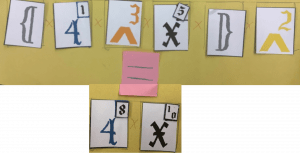Welcome to the first blog post of grade 9! We have just finished our first scimatics project all about exponents. Otherwise known as those little weird numbers that hitch hike on top of other numbers. To complete this project we had to do three main things; Learn about what exponent laws actually are, design a card game that uses at least 4 of them, then add a simple scoring system so that you and your friends could be way too competitive over just little game. Throughout all of that, we will also be answering the question, how does math make games more complex, interesting, and re-playable. Let’s get into it.
First let’s start with the most interesting thing, the game. Our game was called Castle Quest. It was a loose take on trading card games like Hearthstone, Magic the Gathering, Legends of Runeterra, and Pokémon? (I never got into Pokémon so I could be wrong on that one). The simple premise was that you put down cards onto the field (in our case exponent and base cards), then battled your opponent’s cards until one person has destroyed the other person’s base.

You Can Read our Finished Rules Here👇
Applying and Innovating
Before we get into the creation of the game, I had Max for my partner for this project! You can check out his blog here. As always having a partner means we can bounce ideas back and forth to see which ones are actually good, and which ones are complete trash. During the project, we also spent quite some time on learning what the exponent laws actually were, and it’s always great to collaborate on those just in case somebody messes up, as well as helping each other if things don’t make sense. I think we both worked hard, especially on the appearance which in my opinion looks really good. We could have put a bit more effort into making the game rules look good as well, but in the end I think we both used class time very effectively to get this game done in time.
Communication and Representing

Incorporating mathematical ideas into a game was one of the main challenges of this project. How we managed to incorporate the mathematical ideas, was by including a unique turn called combining. When someone did this, they could combine all their cards into a couple more powerful cards. The magic of this game mechanic was that when you combined your cards, you would use exponent laws to calculate what the new cards were going to be. This let us use most of the exponent laws without making the game super complicated, since the players could just build equations like they would normally do in math. Since we also made the cards look like the actual mathematical symbols, it made the game really intuitive to understand if you knew the exponent laws. It could even be a good learning tool for anybody who didn’t know what the exponent laws were, which is a win in my book.
Reasoning and analyzing
One of the other main focuses of designing the game was a simple and intuitive points system. Our points system went through a few iterations. The first version was to deal the amount of damage that your power was equal to. For example if you had 2^4, you would deal 16 damage. This system had it’s upsides, but also some fairly major issues. The good thing about this system was that it made certain cards more powerful then others. Now higher base cards are better since they will deal more damage, while lower base cards are worse. While this does incorporate a certain level of depth to the game, the downsides didn’t make up for it. Just to name a few of the problems, it was complicated, required a calculator, a huge scoring system that went up to 100, and even

with that it was still too easy to one shot your opponent. I think we all learned that in game design, simple is almost always better. Even if your game is really fun, having it be to super complicated sucks a lot of that fun away for first time players. The best games are simple and intuitive, but manage to keep a large amount of depth to keep players engaged.
Speaking of what makes games good, the driving question of this project was “How does math make games more complex, interesting, and re-playable?” I think that the fun in games comes from the decisions that they force you to make. The more depth that these decisions have without making the game super complicated, the better it is. Math can make these decisions super complex without making the rules complex and hard to understand. Probability is a really good example of this making the players think about “should I play it safe, or should I take a risk and go all in.” Math also makes games more re-playable as it makes the games more random and unpredictable. All in all, including some form of math in your games is a great way of making them more interesting and fun to play, without making it too complicated.
Anyways, thanks for reading my thoughts and reflections on the first project of grade 9. This was a really fun project to complete. I’ve always loved game design, and I also got to do a bit of crafts when building the score counters. However I’m most proud of how the math was incorporated in a really unique way that was mostly intuitive while still making you think like a good game should.
See you next time,
Nolan🎲
